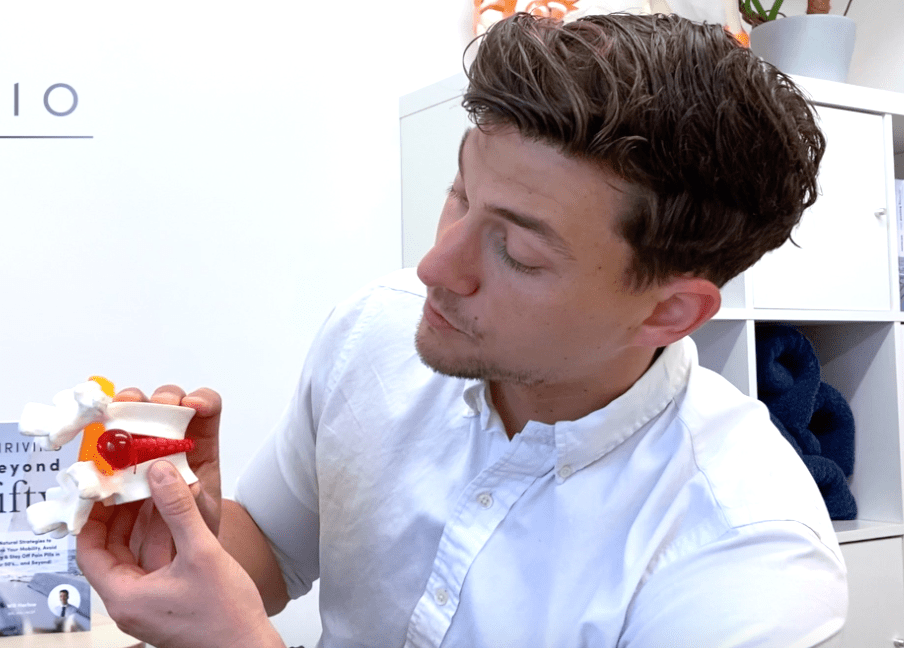A Herniated Disc is an extremely common problem. So common, in fact, that 1 in 10 people will suffer from sciatica at some point in their lives and the vast majority of those cases are caused by a herniated disc. Today, we’re going to talk about the signs that a herniated disc is healing, the symptoms someone with this problem might get and the ideal treatment to get it better as fast as possible!
What are the Signs of a Herniated Disc?
Before we can identify the signs a herniated disc is healing, we must first talk about the initial signs of a herniated disc.
The symptoms of a herniated disc in the lower back include the following:
- Back Pain: Perhaps the most common symptom of a herniated disc is back pain. Now, although this may surprise you, not everyone experiences back pain with a herniated disc, but most people do.
- Sciatica: A pinched nerve from a herniated disc is the most common cause of sciatica. Sciatica is the word we use to describe the sensation of pain the runs down the back of the leg. It is usually shooting and can be severe – sometimes described by my clients as feeling like “being stabbed by a hot poker”.
- Pins and Needles/Numbness: A herniated disc can cause sensory changes in the leg and foot. Usually, the funny sensations will be present in the foot and toes and for some people this symptom can be worse than the pain. This symptom happens because the pinched nerve is prevented from doing its job correctly. This means that some signals don’t get through properly and sensation isn’t felt normally.
- Weakness in the Legs: Now, this symptom can be alarming and you should definitely head to your doctor if you feel weakness in one or both legs along with any of the other symptoms on this list. Weakness in the legs (particularly lower leg weakness with a herniated disc L5/S1) indicates a severely pinched nerve from the herniated disc. If this sounds like you, it needs addressing as soon as possible.
How does a herniated disc cause leg symptoms?
Usually, when you get a herniated disc, the symptoms of your sciatica will reflect the particular nerve root within the spine that the disc bulge is irritating.
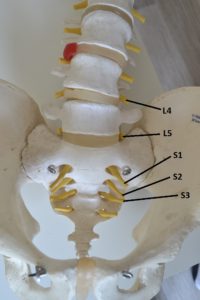
Note that this does not necessarily mean that you will get your symptoms at the exact level of the herniated disc… Let me explain.
When you sustain a herniated disc at level L4/L5 (second from bottom disc) in the spine, you may get an irritation of the L5 nerve root, which exits at the level of your disc problem.
However, due to the effects of gravity, if any material has leaked out from your disc at L4/L5 it may travel downwards within the spine. This means that you may get symptoms reflecting an irritation of the S1 nerve root (just below the base of the spine) due to the inner disc material having traveled south within your back.
This may affect your herniated disc and change how long it takes to heal.
It is also possible that the inflammation that appears in our spine when we suffer a disc injury irritate the nerves above and below the injury too.
The presence of these inflammatory chemicals is likely to increase the time it takes your herniated disc to heal.
This video provides a great explanation for how a disc bulge can cause sciatica:
Signs a Herniated Disc is Healing
Here is a video I made that explains the signs a herniated disc is healing:
There are several signs that a herniated disc is healing to watch out for:
- Less pain in the leg: The first sign that a herniated disc is healing is usually reduced sciatica or pain in the leg. This may present as a lower intensity of pain, or the same intensity but without spreading so far down the leg. For example, if the pain used to spread down to your toes, if it now only reaches your knee this is usually a sign a herniated disc is healing.
- Often, MORE pain in the back: Strangely, one of the signs that a herniated disc is healing is often an INCREASE in pain in the back. This often occurs at the same time that the leg pain improving, and we call this “centralisation” of the pain, which is a McKenzie concept. Don’t worry about this being long-term – eventually, the back pain should also improve as the herniated disc heals further.
- Better sensation: If the herniated disc caused pins and needles or numbness in the lower limbs, a sign that a herniated disc is healing is often a normalisation of sensation.
- Improved strength: If the herniated disc caused weakness in one leg, a sign that the herniated disc is healing is often a return of the strength in that leg.
- Improved sleep: Herniated discs often causes terrible disruption to sleep. We should see sleep improving due to less pain at night as a sign that a herniated disc is healing.
- Improved walking: Feeling like you can walk further or for longer with less pain is a sign that a herniated disc is healing.
- Improved range of motion in the spine: People with a herniated disc often struggle to bend or extend their spine. If you find your range of motion returning, this is usually a sign that a herniated disc is healing.
How Long Should it Take to See Signs that a Herniated Disc is Healing?
There is no simple answer to this question.
Everyone is different and it is difficult to tell who is going to improve very quickly, and who will have a long, drawn-out herniated disc recovery time.
What’s even more confusing is that the severity of the disc herniation is NOT a good predictor of herniated disc recovery time!
Some people have TERRIBLE herniated discs but recover within weeks – while others have a small disc bulge and take months, even years to fully recover.
However, as a rough guideline I would expect a recovery to follow this pattern in an absolutely “typical” individual:
| When? | Stage of recovery |
| Day 1 | Disc injury occurs – severe symptoms! |
| Week 1 | In lots of pain, struggling to get to work or get comfortable at home. Probably feels like you want to cut your leg off. |
| Week 2 | Starting to take the right pain killers, this helps a bit. Work is a killer, leg still extremely painful. |
| Week 4 | Starting to improve slightly after making appropriate lifestyle changes, optimising diet and using the specific exercises to my individual problem. |
| Week 6 | Feeling significantly better. Feeling like you can get through a day at work without too much pain in the evening. Still very wary of your back. |
| Week 9 | Leg is much better but back still stiff. Trying to get that last bit of movement back now. Terrified of the thought of swinging a golf club again. |
| Week 12 | Through practicing methods in order to regain normal function, you’re seeing an improvement in confidence. You feel ready to go back to the things you love but know you need to still be cautious for a while. |
As you can see, recovering from a herniated disc is not a quick thing!
It is likely to dominate your life for a few weeks – but that’s OK. Get it right here and you are less likely to suffer with a recurrence later on.
Remember, everyone is different in terms of herniated disc recovery time. I have seen patients who feel no better after 12 weeks of treatment, and I have seen patients who report being 90% better after one week. This statement still stands when you compare the initial severity of each of these cases.
How a Herniated Disc is Treated
When we talk about treatment for a herniated disc, we need to split this category into two parts:
- Lifestyle
- Exercise
Before we go any further, in the following video, I’ll share 8 effective strategies to SPEED UP the recovery of a bulging disc or herniated disc naturally:
How a Herniated Disc is Treated Part #1: Lifestyle
Diet
It’s crucial that you optimise your diet if you want to see signs a herniated disc is healing.
This involves maximising anti-inflammatory foods: click HERE to learn more about anti-inflammatory foods for a herniated disc.
You’ll also need to minimise pro-inflammatory foods: click HERE to learn about which foods to AVOID when you have a herniated disc.

General Activity
You need to keep generally active if you want to see signs a herniated disc is healing. This means not taking too much time off work.
You should try to walk as much as you can within the realms of comfort. Stop when pain starts, have a break, then get back to it.
One of my clients used to leave his house, walk up the road 100 yards, then come back. That was it for each day. But even those few hundred steps made a huge difference over a number of weeks.
Little and often is key – don’t overdo it. Make sure you stop as soon as your pain starts to worsen. Each day, you’ll be able to build your activity level gradually. This is a sign a herniated disc is healing.
Hydration
Drinking plenty of water is absolutely crucial. When you have a herniated disc compressing a nerve, any dehydration in that disc will make the compression worse.
This means that drinking 3-4 litres of water each day is critical to your success and a highly undervalued facet of recovery.

Sleep
Getting as much sleep as possible is incredibly important when you have a herniated disc (although, sciatica can make sleep more difficult unfortunately).
Sleep is one of the key parts of a recovery from a herniated disc – sleep is when healing occurs. It’s impossible to get better without ample sleep each night.
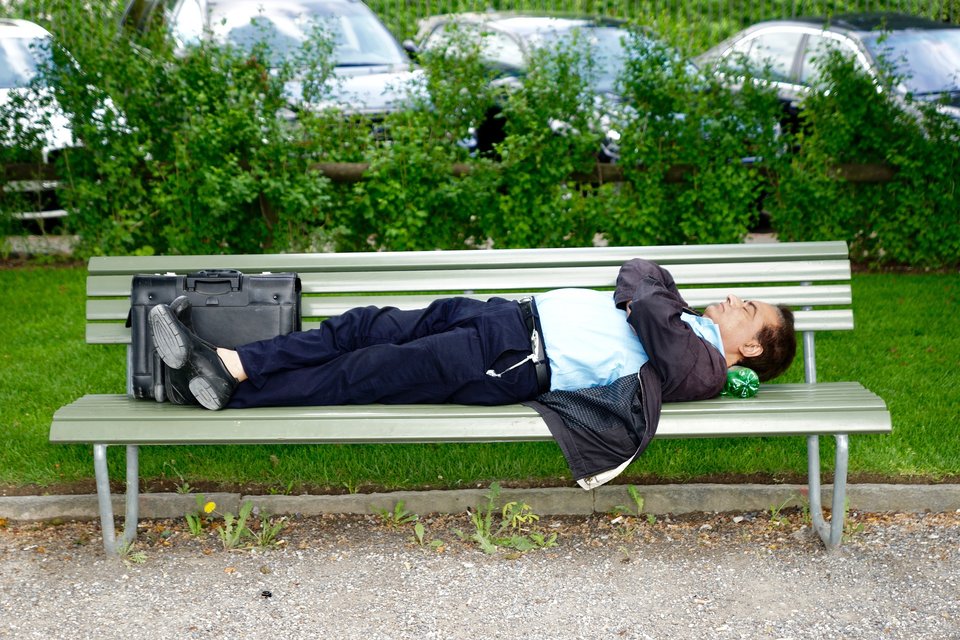
One helpful tip to remember is that you can make up for lost hours of sleep as a nap if your pain tends to be worse at night. A 20-minute nap has been shown to be as effective as two hours of extra sleep in the morning in terms of restoration, some research shows.
Click HERE for a brief guide on sleeping better when you have sciatica.
Minimising Discomfort to Speed Up Recovery
Getting better from a herniated disc is just as much about avoiding making the problem worse as it is about doing extra things.
As a general rule of thumb, if an activity or position is making your pain worse, you need to change it or you run the risk of delaying your herniated disc recovery time.
Products That Can Help a Herniated Disc
For a herniated disc, there are a number of products that can help you go about your day with less pain and more comfort. Here are a few of my top recommended products for treating sciatica:
#1 – TENS Machine
TENS machines are useful for providing relief from pain and muscle spasms in the back and legs. They are a safe and effective way of relieving your symptoms without any effort on your part.
Below are 3 of my top recommended TENS machines for relief from sciatica:
TENSCare Perfect TENS Pain Relief Machine


This TENS machine for sciatica has 8 preset programs so you don’t need to “tune it” yourself – just pick a setting and off you go!
There is an option to purchase a ‘Value Pack’ which includes spare pads which I would definitely recommend.
Click HERE to view the TENSCare Perfect TENS Pain Relief Machine on Amazon US (closest match)
Click HERE to view the TENSCare Perfect TENS Pain Relief Machine on Amazon UK
TPN 200 Plus TENS Machine


A super-simple yet sleek design, this TENS machine is perfect for those who want a highly effective model and are confident with using a TENS machine for sciatica pain relief.
This unit doesn’t have a fancy display, so you can customize the settings to best suit your needs, tweaking and changing the frequency until you find one that works best for you.
Click HERE to view the TPN 200 Plus TENS Machine on Amazon UK
Click this link here to read about our 10 Best Recommended TENS Machines for Sciatica!
#2 – Lumbar Roll
A lumbar roll is a specially designed cushion that goes behind your lower back when sitting.
It increases the curve in the lower back, which many people find takes pressure off a herniated disc when sitting (which can be the worst position for a lot of people).
Here is a great option for a lumbar roll for the office, car and home:


Click HERE to view the Supportiback® Posture Therapy Lumbar Support Cushion on Amazon
#3 – How to Treat a Herniated Disc with Topical Creams
There are a number of rubs and creams that can help to relieve pain from sciatica. In this section of the article, I’m going to share with you which products I believe to be the best creams for sciatica pain relief.
Always consult your doctor before starting any new medication, including creams.
Best Cream for How to Treat a Herniated Disc – Voltarol


Click HERE to view Voltarol cream for sciatica pain relief Amazon US
Click HERE to view Voltarol cream for sciatica pain relief Amazon UK
This product contains an anti-inflammatory that helps to calm any inflammation around the affected nerve root when someone is suffering from a herniated disc.
What’s more, it also contains a natural product that will help to relax hyper-tense muscles and reduce pain, as well as provide a soothing effect to the area.
For this reason, I would place it as my go-to and best cream for herniated disc pain relief.
Second Best Cream for Treating Herniated Disc – 5Kind Hemp Active Gel


View this product on Amazon here
Hemp-based products have grown in popularity over the last few years. I always keep a close eye on the research regarding hemp and CBD – and the research shows mixed results.
Anecdotally, I’ve heard great things from users of hemp gel as a cream for sciatica pain relief, and I had one client that used it to relieve back pain to great effect.
The product shown is one of the best on the market right now with over 11,000 ratings and an average of 4.5/5 stars!
Third Best Cream for Treating a Herniated Disc – FourFive CBD Muscle Rub

Click HERE to view this cream for sciatica pain relief on Amazon
I was never convinced by the CBD craze when it all began, but I am starting to see more compelling evidence for its use in some people, in some cases.
While I don’t believe CBD to be “magic”, I do feel this product has potential to relieve some of the muscle pain experienced in the lower back for many people with sciatica.
That is why this product makes it onto the list of the best creams for herniated disc pain relief. Check out the reviews of this product – they are outstanding, with a perfect 5-star rating.
What Other Products Can Help in Treatment of a Herniated Disc?
I’m a big believer in the power of improving your general health when it comes to herniated disc treatment and pain relief.
If you’re struggling with your mobility due to a herniated disc, one thing that might help is to address other general health issues like your weight, your diet and your general exercise.
If you’d like some tips on how to improve all of those aspects of your health, stave off injury and treat problems like arthritis, why not grab a copy of my brand new book, Thriving Beyond Fifty? You can see more details below:
Top Tip: Grab a copy of my #1 Best-Selling book, Thriving Beyond Fifty for more health, wellness and recovery strategies!
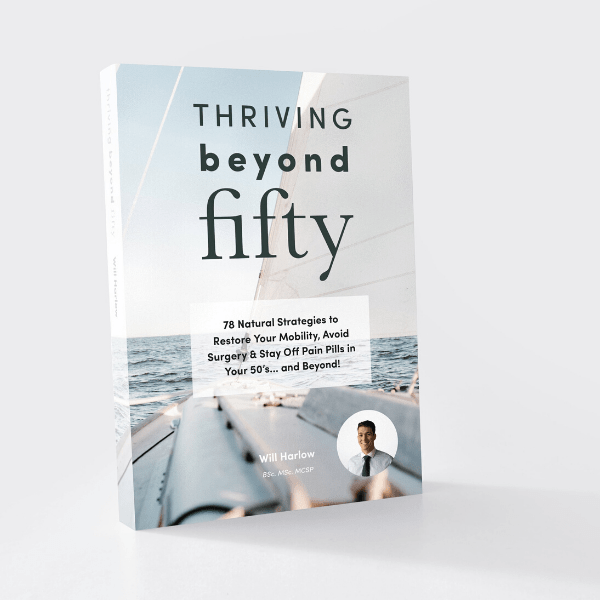
Fastest Way to Get the Signs a Herniated Disc is Healing: Exercises
The most important thing to understand when it comes to a herniated disc and exercise is that everyone is different; a suitable exercise regime for one person with a herniated disc will be different for another with the same problem.
However, there are some exercises that are commonly useful for many people with a herniated disc.
Only choose exercises that are non-painful and don’t make your symptoms worse during and after you finish the exercise.
Always go gently at first and build up slowly. Check with your GP before starting any new exercise programme. Not all of the following exercises are suitable for all.
The exercises provided on this page for informational purposes only and are not designed to be a ‘prescription’ of any kind. Be sure to check with your healthcare provider before you begin any new exercise programme.
#1 – Cobra Pose
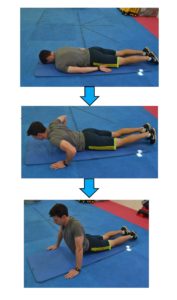
Instructions:
- Begin laying face-down on a firm surface like a mat on the floor or a hard mattress
- Place your hands in line with your shoulders and gently push up, raising your torso off the floor
- Keep your hips down on the floor
- Only go as far as is comfortable – no need to get to full extension for a benefit!
- Gently lower yourself to the starting position and repeat up to a maximum of 10 times.
- Do a set of these 3-4 times per day
Who this is for:
Usually, people suffering with a herniated disc find this exercise one of the most useful for improving their symptoms. However, regardless of what is causing your sciatica, you should only persist with this exercise if it is comfortable to perform this movement. This exercise is a good place to start if you have trouble bending forward.
Why this exercise works as treatment for a herniated disc:
This sciatica exercise works because it involves movement of the lower back which encourages blood to flow to the injured area so healing can occur. Some researchers also believe this exercise causes a disc bulge to “centralise” into the disc where it can’t pinch on a nerve root. This is a sign a herniated disc is healing and something to watch out for.
#2 – Knee Rolls
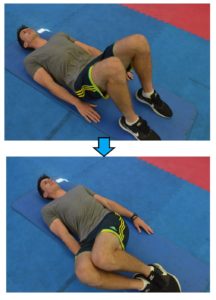
Instructions:
- Lie on your back on a mat or a firm mattress
- Bend your knees up halfway
- Slowly and gently, allow both knees to roll over to one side only as far as is comfortable
- Bring your knees back to the start position, then allow them to roll over to the opposite direction
- Repeat for 30-seconds total, don’t rush the repititions and try to find a rhythm
- Try to find time to do this exercise every 2-3 hours if you can
Who this is for:
This sciatica exercise is great for relieving any tension in tight muscles in the lower back. It is also a great way to begin to regain any lost rotation in the lower back following a herniated disc.
Why this exercise works for treating a herniated disc:
By gently encouraging a slow, controlled rotation of the lower back, the muscles in your lower back will realise that it is OK to relax a little. This will bring about stiffness relief which is a key sign a herniated disc is healing.
#3 – McKenzie Side Bends

Instructions:
- Start standing next to a wall. Most people prefer to do this exercise with their painful leg being the one FURTHEST AWAY from the wall. However, try both sides and see which one is most comfortable for you – stick with that one.
- Use your elbow and forearm to support yourself so you are leaning on the wall (1st picture)
- Slowly and gently, let your hips “glide” towards the wall while keeping your feet in the same position.
- Only go as far as is comfortable, then return to the start position.
- Repeat this 10 times, have a break, and do 3 sets total.
- If this exercise has worked for you, you may feel rapid relief in the painful leg and possibly slightly worsening back pain – rest assured this is a normal phenomenon.
Who this is for:
This exercise works really well for disc problems and is a mainstay for a treatment approach called “McKenzie”. If you have pain in one leg only from a disc bulge or prolapse, you could try this exercise. It brings significant sciatica pain relief to many people and can work rapidly.
Why this exercise works for treating a herniated disc:
The McKenzie approach claims to work by encouraging the disc material called the “nucleus pulposus” to re-centralise into it’s inner middle. Whether or not this actually occurs hasn’t been proven in scientific literature but I have seen this exercise provide relief for many. Be sure to choose the direction that is least painful when performing this sciatica exercise.
Other Options for How to Treat a Herniated Disc
Very rarely, surgery is required for a herniated disc. This intervention is reserved for those who have tried everything else and are still suffering.
It’s important to exhaust all non-surgical methods first, as you can’t reverse a surgery and the results from surgery are often underwhelming. Occasionally, surgery can make someone worse which is obviously devastating to hear about.
Herniated Disc Surgery
Surgery is occasionally required when you have no signs a herniated disc is healing even after 10-12 weeks of treatment. You may also require surgery if you are experiencing any of the “red flag” symptoms that can indicate a more serious nerve compression. These symptoms include (but are not limited to):
- Bladder and bowel problems (like incontinence or not being able to “go”)
- Numbness in the saddle region
- Severe loss of strength in the legs
In all cases you should get a professional opinion from a doctor or physical therapist specific to your personal circumstances.

The surgeries that are offered to people whose bulging disc recovery time exceeds what is expected are as follows:
- Microdiscectomy: Where a small part of the offending disc is removed in order to decompress the affected nerve.
- Laminectomy: Where a part of the vertebral bone in the affected level called the “lamina” is removed, in order to create more space for the disc in hope that the bulge will not compress so heavily on the nerve root.
- Spinal fusion: Where the disc is removed and the vertebrae above and below the offending disc are fused together through use of rods and screws.
Another option includes injections, which can give pain relief down the course of the sciatic nerve. From my experience, these have very underwhelming results for most people. However, they can occasionally be effective.
A further option is a PROVEN exercise programme, like the one below that I proudly support:
Are You Looking for RAPID Relief from Sciatica?
My good friend, colleague and fellow international sciatica expert, Dean Volk, has a brand new sciatica relief video course available – and I’m delighted to be an official sponsor!
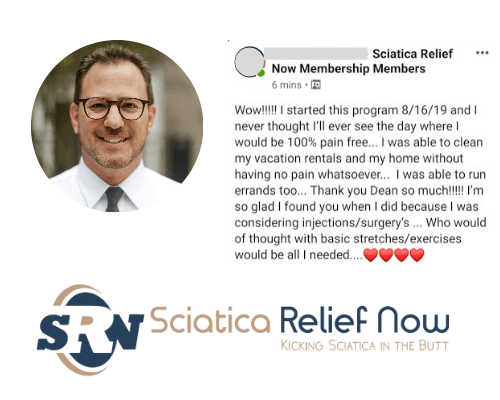
Check out Dean Volk’s “Kicking Sciatica OUT of the Butt!” Online Pain Relief Course Here!
I can proudly recommend Dean and his course for sciatica sufferers – because I’ve seen his incredible results first-hand. You can check out his course (and get lifetime access to the videos and bonus content) by clicking HERE.
Top Tip: Grab a copy of my #1 Best-Selling book, Thriving Beyond Fifty for more health, wellness and recovery strategies!

The information on Overcome Sciatica should never be used as a substitute for medical advice from a doctor. Never put into action any tips or techniques from Overcome Sciatica without checking with your doctor first. Please see full terms of use here.
Conclusion
I hope you’ve found this article helpful. I think it’s useful to understand exactly what signs a herniated disc is healing you should be looking out for, so the symptoms and recovery process make more sense. I also hope you find some of the exercises in this article useful.
Remember, getting the signs a herniated disc is healing is just as much about how you manage your day in a way that doesn’t make the symptoms worse as it is about doing exercises to fix it.
What did you think of this article? Was it useful? Leave me a comment below and let me know!

